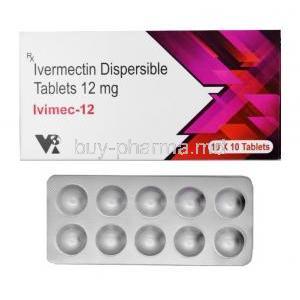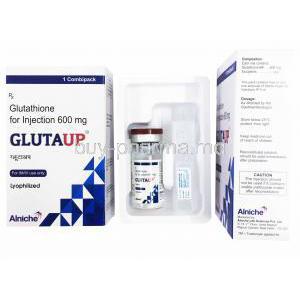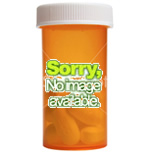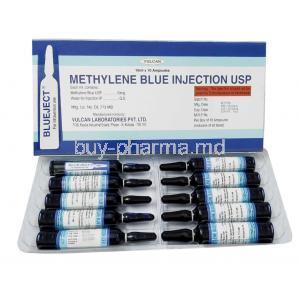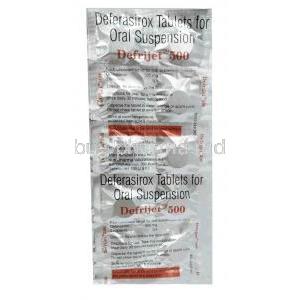Introduction
Overview of Methylene Blue Injection
Methylene Blue Injection is a pharmaceutical compound primarily used in medical treatments requiring redox-active agents. Classified as a heterocyclic aromatic chemical compound, it plays a crucial role in cellular respiration and oxidative stress modulation.
Historically, methylene blue was first synthesized in 1876 and quickly found applications in various medical fields. Initially used as a textile dye, its medicinal potential was soon realized, leading to its widespread adoption in treating methemoglobinemia, urinary tract infections, and even as an antiseptic agent.
General Uses of Methylene Blue Injection
- FDA-Approved Uses: Treatment of methemoglobinemia, urinary tract antiseptic applications, and diagnostic staining.
- Off-Label Applications: Investigated for septic shock, neurodegenerative diseases, psychiatric disorders, malaria, and cancer therapies.
Composition and Formulation
Active and Inactive Ingredients
Methylene blue consists of a thiazine dye structure, acting as an electron carrier. Its chemical composition includes methylthioninium chloride, with varying excipients such as sodium chloride for isotonicity and water for injection.
Available Strengths and Dosage Forms
Methylene blue is primarily available as an intravenous (IV) injection, with common concentrations ranging from 0.5% to 1% solutions. Alternative formulations include oral tablets and topical preparations, although IV administration remains the preferred route for acute conditions.
How Methylene Blue Injection Works
Mechanism of Action
- Acts as a redox agent, facilitating electron transfer and cellular respiration.
- Functions as a monoamine oxidase inhibitor (MAOI), influencing neurotransmitter levels.
- Interacts with mitochondrial enzymes, aiding in the management of oxidative stress-related disorders.
Pharmacokinetics and Metabolism
Upon administration, methylene blue is rapidly absorbed, distributed across tissues, metabolized in the liver to leukomethylene blue, and excreted via urine. Its half-life varies based on dosage and patient metabolism.
FDA-Approved Uses of Methylene Blue Injection
Treatment of Methemoglobinemia
Methemoglobinemia, a condition where hemoglobin is oxidized, impairing oxygen delivery, is effectively reversed by methylene blue. By acting as an electron donor, it reduces methemoglobin back to functional hemoglobin, restoring normal oxygen transport.
Use in Urinary Tract Infections (UTIs) and Diagnostic Applications
Methylene blue serves as a urinary antiseptic, altering bacterial activity and aiding in infection control. Additionally, it is widely employed in diagnostic procedures, particularly in surgical staining and tissue visualization.
Off-Label Uses of Methylene Blue Injection
Use in Septic Shock and Vasoplegia
In cases of septic shock, methylene blue helps counteract vasodilation by inhibiting nitric oxide synthase, stabilizing blood pressure, and improving vascular tone.
Treatment of Neurodegenerative Disorders
- Under investigation for Alzheimer's and Parkinson's disease.
- Potential to enhance mitochondrial function and reduce oxidative damage in neurons.
Use in Psychiatric Disorders
Due to its MAOI properties, methylene blue is studied as an adjunct treatment for mood disorders, including depression and bipolar disorder.
Role in Malaria and Parasitic Infections
Historically used in malaria treatment, methylene blue disrupts Plasmodium parasite metabolism, offering an alternative to conventional antimalarial drugs.
Methylene Blue in Cancer Therapy
Investigated for photodynamic therapy, methylene blue enhances the efficacy of light-based treatments in targeted cancer cell destruction.
Dosage and Administration
Recommended Dosage for FDA-Approved Indications
The standard dose for methemoglobinemia treatment is 1-2 mg/kg administered via slow IV infusion over 5-30 minutes. Repeat dosing may be necessary based on clinical response.
Dosage for Off-Label Uses
- Dosing varies significantly depending on condition and research protocols.
- Healthcare providers tailor administration based on patient response and tolerability.
Method of Administration
Methylene blue is administered intravenously, requiring careful monitoring to prevent potential adverse effects. Proper dilution and slow infusion help minimize complications.
Side Effects of Methylene Blue Injection
Common Side Effects
- Gastrointestinal Distress: Nausea, vomiting, diarrhea.
- Discoloration: Temporary blue-green urine and skin staining.
- Cardiovascular Effects: Mild hypotension or tachycardia in some cases.
Serious Adverse Reactions
- Hemolytic Anemia: Particularly in individuals with G6PD deficiency.
- Respiratory Issues: Dyspnea and hypersensitivity reactions.
- Neurotoxicity: High doses can cause serotonin toxicity, especially when combined with SSRIs.
Long-Term Side Effects and Risks
Prolonged use may contribute to mitochondrial dysfunction, exacerbating oxidative stress conditions. Patients with chronic illnesses should use it cautiously under medical supervision.
Drug Interactions
Interactions with Other Medications
Methylene Blue Injection exhibits significant interactions with various pharmaceutical agents, necessitating meticulous consideration when co-administered. One of the most concerning interactions is its potential to induce serotonin syndrome when combined with serotonergic antidepressants, such as selective serotonin reuptake inhibitors (SSRIs) and serotonin-norepinephrine reuptake inhibitors (SNRIs). Symptoms of serotonin syndrome include hyperthermia, autonomic instability, neuromuscular excitability, and altered mental status.
Additionally, methylene blue functions as a monoamine oxidase inhibitor (MAOI), which can interfere with other MAOIs, leading to excessive accumulation of neurotransmitters like dopamine, norepinephrine, and serotonin. This interaction may precipitate hypertensive crises, profound agitation, and cardiovascular complications.
Interaction with Anesthetics and Surgical Drugs
Special caution is warranted when administering methylene blue to patients undergoing surgical procedures. Its vasoconstrictive properties may counteract the effects of vasodilatory anesthetic agents, leading to hemodynamic instability. Additionally, methylene blue has been reported to interfere with pulse oximetry readings, potentially resulting in misleading oxygen saturation levels during surgery.
In certain cases, it may exacerbate methemoglobinemia if used concurrently with local anesthetics such as benzocaine and prilocaine. Preoperative assessment should include a thorough evaluation of all medications to mitigate adverse intraoperative outcomes.
Contraindicated Medications
- SSRIs, SNRIs, and Tricyclic Antidepressants: Risk of serotonin syndrome.
- Other MAOIs: Increased potential for hypertensive crisis.
- Sympathomimetic Agents: May potentiate hypertensive responses.
- Opioids (e.g., Tramadol, Meperidine): Increased risk of neurotoxicity and serotonin syndrome.
Alternative medications should be considered to minimize the risk of severe drug interactions. In cases where methylene blue is necessary, careful monitoring and dose adjustments are imperative.
Contraindications and Warnings
Absolute Contraindications
Certain patient populations should not receive methylene blue due to the high risk of adverse effects. Individuals with a documented hypersensitivity to methylene blue or any of its components must avoid administration to prevent severe allergic reactions, including anaphylaxis.
Another critical contraindication is the presence of glucose-6-phosphate dehydrogenase (G6PD) deficiency. Methylene blue can induce hemolytic anemia in affected individuals, leading to rapid red blood cell destruction, jaundice, and potentially life-threatening hemolysis.
Relative Contraindications and Cautionary Use
- Cardiovascular Conditions: Patients with hypertension or unstable cardiovascular disease require close monitoring.
- Neurological Disorders: Those with seizure disorders or a history of psychiatric conditions should avoid high doses.
- Renal and Hepatic Impairment: Methylene blue metabolism is altered in these patients, necessitating dose adjustments.
In these populations, benefits must be carefully weighed against the risks, and alternative treatments should be explored where applicable.
Precautions and Careful Administration
Administration to Elderly Patients
Aging alters drug metabolism and excretion, necessitating dose modifications in elderly individuals. Reduced renal clearance may lead to prolonged drug retention and increased toxicity. Clinicians should initiate therapy at lower doses, titrating based on clinical response and renal function.
Administration to Pregnant Women and Nursing Mothers
Methylene blue crosses the placental barrier and may exert teratogenic effects in the developing fetus. Studies suggest an increased risk of fetal anomalies, particularly when administered during the first trimester. As a result, its use in pregnancy is generally discouraged unless the benefits outweigh the potential risks.
For lactating mothers, methylene blue is excreted in breast milk, posing risks to nursing infants. Breastfeeding should be discontinued for at least 24-48 hours post-administration to prevent neonatal exposure.
Administration to Children and Infants
Pediatric patients may require weight-based dosing, with careful monitoring for neurotoxicity. Premature infants and neonates are particularly susceptible to oxidative stress-related complications, necessitating cautious administration in this population.
Overdose and Toxicity Management
Signs and Symptoms of Overdose
- Severe methemoglobinemia, leading to cyanosis and respiratory distress.
- Cardiovascular abnormalities such as tachycardia, hypertension, or hypotension.
- Neurological manifestations, including confusion, hallucinations, and seizures.
- Potential for acute renal impairment due to toxic metabolite accumulation.
Emergency Management and Antidotes
Immediate discontinuation of methylene blue is the first step in overdose management. Supportive care, including supplemental oxygen therapy and intravenous fluids, can mitigate symptoms. Severe cases may require the administration of activated charcoal to limit further absorption.
In instances of refractory toxicity, exchange transfusion or hemodialysis may be considered for rapid drug clearance. Clinicians must monitor vital signs and organ function closely throughout the recovery period.
Storage and Handling Precautions
Proper Storage Conditions
Methylene blue should be stored in a controlled environment to maintain its stability. Recommended storage conditions include:
- Temperature range: 15°C to 30°C (59°F to 86°F).
- Protection from direct light and moisture.
- Avoidance of extreme temperature fluctuations to prevent chemical degradation.
Safe Handling and Disposal
Healthcare providers must adhere to standard safety protocols when handling methylene blue. Accidental exposure to skin or mucous membranes should be promptly rinsed with water. Proper disposal methods include:
- Discarding expired or unused solutions according to hazardous pharmaceutical waste guidelines.
- Utilizing designated biohazard containers for contaminated materials.
- Following institutional and regulatory standards for the disposal of oxidizing agents.
Conclusion
Methylene Blue Injection remains a critical therapeutic agent with diverse medical applications. Its primary role in treating methemoglobinemia is well-established, while emerging research continues to explore its potential in neurodegenerative disorders, psychiatric conditions, and oncology.
Despite its benefits, careful administration is paramount due to its extensive drug interactions, contraindications, and toxicity risks. Healthcare professionals must exercise vigilance in prescribing methylene blue, ensuring appropriate patient selection and monitoring.
Future research endeavors aim to refine its clinical utility, expand therapeutic indications, and optimize safety profiles. As investigations continue, methylene blue's role in modern medicine is likely to evolve, paving the way for novel applications and improved patient outcomes.
Methylene Blue. Injection FAQ
- Is methylene blue harmful to humans?
- What is the methylene blue method used for?
- What does methylene blue do in the body?
- What are the benefits of methylene blue infusion?
- Is methylene harmful to humans?
- Is methylene blue safe for kidneys?
- Who should not take methylene blue?
- Is methylene blue FDA approved?
- Can you take methylene blue daily?
- When is the best time to take methylene blue?
- Is methylene blue an antibiotic?
- What disease is treated with methylene blue?
- What are the disadvantages of methylene blue?
- Is methylene blue good for heart?
- What is the risk of methylene?
- What does methylene do to your body?
- Can methylene blue cause kidney stones?
- Is methylene blue harmful to humans?
- What is the methylene blue method used for?
- Is methylene blue safe for kidneys?
- Who should not take methylene blue?
- Can you take methylene blue daily?
- When is the best time to take methylene blue?
- Is methylene blue an antibiotic?
- What disease is treated with methylene blue?
- Is methylene blue good for heart?
- What is the risk of methylene?
- What does methylene do to your body?
- Can methylene blue cause kidney stones?
Is methylene blue harmful to humans?
When methylene blue is taken at a dose of 2 mg/kg, it is considered safe, but if the levels exceed 7 mg/kg, then it can lead to various adverse effects.
What is the methylene blue method used for?
It is employed to draw attention to cells in the course of medical examinations.
What does methylene blue do in the body?
Boosted Oxygen Usage and Healing Benefit; Methylene blue enhances the capacity of your body to transport oxygen to your cells and ensures efficiency in utilizing that oxygen for functions.
What are the benefits of methylene blue infusion?
Enhances energy levels, enhances function and mental clarity, promotes health, combats persistent infections, and decreases oxidative stress.
Is methylene harmful to humans?
Yes
Is methylene blue safe for kidneys?
It's best to steer clear of using blue therapy for individuals with significant kidney issues, and it's advisable to be cautious when giving it to those with mild to moderate kidney problems.
Who should not take methylene blue?
Avoid using methylene blue if you are expecting a child, nursing or within eight days after your dosage of the medication unless it is not administered intravenously.
Is methylene blue FDA approved?
Yes
Can you take methylene blue daily?
The effective therapeutic benefits are typically seen with low-dose methylene blue, which is typically prescribed at a dosage ranging from 10 to 30mg.
When is the best time to take methylene blue?
Morning
Is methylene blue an antibiotic?
Methylene blue, a phenothiazine dye, possesses the ability to stain biofilms and exhibits other properties.
What disease is treated with methylene blue?
Injectable methylene blue is administered to address a condition known as methemoglobinemia, which arises when the bloodstream fails to transport oxygen to the necessary parts of the body.
What are the disadvantages of methylene blue?
MB is toxic, carcinogenic, and non-biodegradable
Is methylene blue good for heart?
Administer methylene blue while performing CPR to enhance heart function and reduce lactate levels.
What is the risk of methylene?
After the risk assessment review, it was concluded that methylene chloride poses a health risk that is considered unreasonable in its usage conditions.
What does methylene do to your body?
The FDA approves the compound Methylene Blue for treating methemoglobinemia and cyanide poisoning conditions in humans. It is recognized for its ability to improve function through boosting oxygen consumption and complex IV activity while also serving as an electron carrier to lower the production of reactive oxygen species (ROS) and showcasing protective effects on the nervous system.
Can methylene blue cause kidney stones?
It might help prevent the formation of stones.
Is methylene blue harmful to humans?
At doses, below 2 mg/kg of methylene blue are deemed safe for use, as a drug but adverse effects tend to manifest when the dosage exceeds 7 mg/kg.
What is the methylene blue method used for?
It is commonly utilized to point out cells in the course of medical examinations.
Is methylene blue safe for kidneys?
It's best to steer clear of using blue therapy in individuals with serious kidney issues and to proceed with caution when giving it to those with mild to moderate kidney problems.
Who should not take methylene blue?
Avoid using methylene blue if you are expecting a baby or nursing a child since it's not safe for them while taking the medication or up to 8 days after the dose unless it is administered intravenously.
Can you take methylene blue daily?
The effective therapeutic dose of low-dose methylene blue typically ranges from 10 to 30 milligrams per day.
When is the best time to take methylene blue?
Morning
Is methylene blue an antibiotic?
Methylene blue, a dye belonging to the phenothiazine group can stain biofilms. Also, it exhibits properties.
What disease is treated with methylene blue?
When methylene blue injection is administered, it helps address an issue known as methemoglobinemia, which arises when the blood fails to transport oxygen to the necessary areas in the body.
Is methylene blue good for heart?
Using methylene blue as part of CPR can enhance heart health and lead to reduced lactate levels.
What is the risk of methylene?
The latest assessment of risk concludes that methylene chloride poses a health hazard that is deemed excessive under its usage conditions.
What does methylene do to your body?
A substance called Methylene Blue is approved by the FDA for treating methemoglobinemia and cyanide poisoning cases in humans. It has the ability to improve the function of mitochondria by enhancing oxygen usage and complex IV activity. This compound also serves as an electron carrier to reduce the production of reactive oxygen species (ROS) and has been shown to have protective effects on the nervous system.
Can methylene blue cause kidney stones?
It could be helpful in stopping the development of stones.



